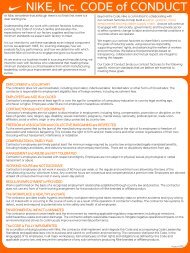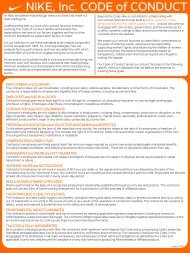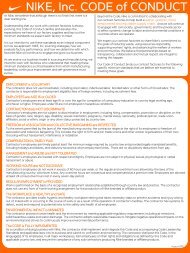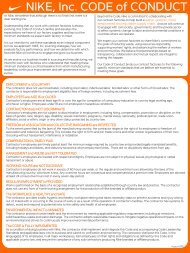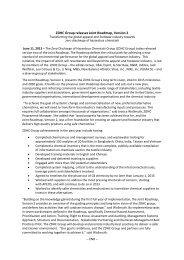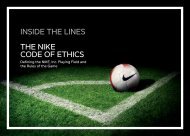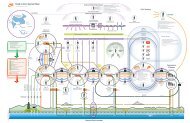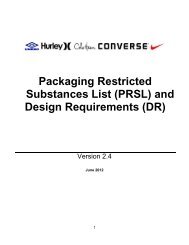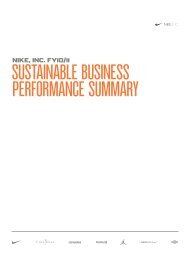COC CLS - Healthy Safety Environment - NIKE, Inc. - The Journey
COC CLS - Healthy Safety Environment - NIKE, Inc. - The Journey
COC CLS - Healthy Safety Environment - NIKE, Inc. - The Journey
Create successful ePaper yourself
Turn your PDF publications into a flip-book with our unique Google optimized e-Paper software.
MACHINE GUARDING<br />
STANDARD<br />
<strong>The</strong> contractor provides a safe, hygienic and healthy workplace setting and takes necessary steps to<br />
prevent accidents and injury arising out of, linked with or occurring in the course of work or as result of<br />
the operation of contractor’s facilities. <strong>The</strong> contractor has systems to detect, avoid and respond to<br />
potential risks to the safety and health of all employees.<br />
‣ Develop and implement process and procedures to reduce or eliminate risk associated with<br />
injuries due to moving machine parts.<br />
RESPONSIBILITIES<br />
Location Manager must ensure that the machine guarding procedures are developed, implemented<br />
and followed.<br />
HSE Representative must establish, maintain and administer the machine guarding procedures.<br />
Managers and Supervisors must ensure that employees are trained and adhere to the requirements of<br />
the machine guarding procedures.<br />
Employees must adhere to the requirements of the machine guarding procedures.<br />
DEFINITIONS<br />
• Elevator is a lifting device consisting of a platform or cage that is raised and lowered mechanically<br />
in a vertical shaft in order to move people or materials from one floor to another in a building.<br />
• Lockout/Tagout (LOTO) refers to specific practices and procedures to safeguard employees from<br />
the unexpected energization or startup of machinery and equipment, or the release of hazardous<br />
energy during service or maintenance activities.<br />
• Machine guarding are methods to protect the operator and other employees in the machine area<br />
from hazards such as ingoing nip points, rotating parts, flying debris and sparks. Examples of<br />
guarding methods are barrier guards, twohand tripping devices, interlocks, etc..<br />
REQUIREMENTS<br />
1. RISK ASSESSMENT—Each facility must have a documented machine guarding risk assessment<br />
performed which includes as a minimum:<br />
a. Survey of all machines and equipment for hazards associated with moving machine parts.<br />
b. Evaluation of risk associated with hazards.<br />
c. Identification and implementation of control measures to reduce the risk (e.g. fixed guards,<br />
interlocks, two-hand controls).<br />
2. POLICIES & PROCEDURES—Each facility must have implemented procedures to reduce or eliminate<br />
the risk of an injury from moving machinery parts, which must cover, as a minimum, the following:<br />
a. Evaluation for new and/or modified equipment considering first eliminating then protection<br />
against hazards.<br />
<strong>Safety</strong> <strong>CLS</strong> – Page 1<br />
04.14.10



